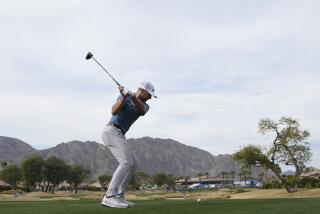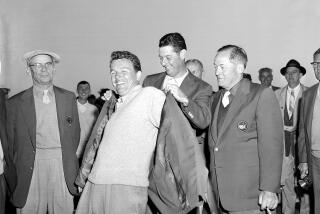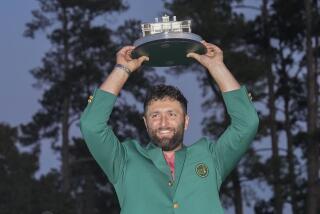This Harvie Was Almost Invisible Too
- Share via
LA QUINTA, Calif. — I had a talk with one of the best players in the long annals of golf here the other morning.
Sam Snead? No. Although Sam is one of the storied golfers here for the Liberty Mutual Legends of Golf tournament at PGA West this week.
Arnold Palmer? No, although he’s here too. Gary Player? Nope. You’re not even warm.
The player I refer to is E. Harvie Ward. Himself. Making a rare appearance.
What? You never heard of him? Well, of course, you didn’t. Figures.
But back in the ‘50s in California, you would have.
California produced a coterie of great strikers of the ball in those days. There was Gene Littler. He went on to win a U.S. Open and 25 other tournaments on the PGA Tour. There was Billy Casper. Billy won two U.S. Opens, a Masters and more than 50 tournaments. There was Ken Venturi. A U.S. Open and 13 others.
Harvie Ward was as good as any of them. Lots ofpeople thought he was better. But he never won a pro tournament.
It’s a long story. And in a way, kind of a sad one.
No one played the game any better than Harvie Ward. Whippet-thin, ballet-graceful, he played the game with a kind of pure joy; it was a pleasure to watch. A classic swing, an all-world short game. Inventive. Daring.
He played with the best. He was a favorite partner of Bing Crosby’s. His skill was recognized in every locker room in America. He was no secret.
He won the NCAA title at North Carolina in 1949. He won the U.S. Amateur twice--in 1955 and 1956. And that’s the only place you will see his name in the player guides. A pity.
So, he won two majors. The Amateurs qualify, even today. He also won the British Amateur, never lost a Walker Cup match.
What he didn’t do was turn pro. It was not unusual in that day. The pro pot was nowhere as full as it is today. You got $2,000 for winning the U.S. Open. Today, you get $350,000. The leading money winner in 1951 (Lloyd Mangrum) got $26,088.83 for the year. Last year’s leading money winner (Greg Norman) got $1,654,959.
So, in 1951, Harvie Ward did not feel he was depriving himself, giving away the store, by not turning pro. Even Jack Nicklaus gave serious thought to remaining amateur back in the late ‘50s.
What Harvie had done was fall in with a San Francisco auto dealer named Ed Lowery, who collected golfers the way some people collect Rembrandts. Lowery, who had caddied for Francis Ouimet back in 1913, added Harvie to his collection.
Harvie Ward became a legend around the golf courses of Northern California. People came from miles around to watch him; locker rooms emptied when he teed off.
How good was he? Well, in the mid-’50s, his mentor, Lowery, given to boasting about his pair of “kids,” Harvie Ward and Ken Venturi, found himself setting up a historic match for his proteges.
It is part of the hidden history of golf. You won’t find it in any book or archive, but a historic four-ball was arranged with a side bet between Lowery’s “kids” and--get this--Ben Hogan and Byron Nelson.
It should have been on pay-per-view, if they had had such a thing.
They scheduled the match for Pebble Beach, to throw the public off the scent, and then repaired to Cypress Point.
The Guinness Book of World Records should have covered it. “There were 22 birdies in the round,” recalls Harvie, still shaking his head. “Hogan chipped in on No. 10 for an eagle--and that was the difference. He ran down an eight-foot putt on 18 to give them the match by one shot.”
That’s how good Harvie Ward was. And Venturi. Hogan needed chip-ins to beat them.
In 1955, when the U.S. Open was played at the ridiculously difficult Olympic Club, where Hogan and Jack Fleck played off for the title after shooting 287 on a par 70--Harvie Ward led after two rounds with 71-73.
He was paired with Doug Ford in the 1957 Masters when Ford won it, and Harvie might have, except he lipped out putts on 16, 17 and 18 to finish fourth. It was no secret he was one of the top players in the world.
In 1957, the USGA, frowning on his relationship with Lowery, banned him from its competition for two years. But not even that could persuade Harvie to turn pro.
A tragedy, in the view of most denizens of the press tent. But Harvie is not so sure.
“It was not till Arnold Palmer came along--and President Eisenhower--that golf got onto Page 1 and into the big television money,” he points out.
His ship never came in, even though he managed a nice living in the automobile business and the stock market. When he finally turned professional--in 1973--it was too late. He was 48.
Even the senior tour was not a salvation. “In those days, the senior tour--what there was of it--was for the over-55,” he said. “They didn’t change it to the over-50 until Arnold Palmer reached 50. So, I was 56 before I got to play the seniors.”
You might say he lost all four ways. You have to wonder what might have happened all those years ago if Harvie hadn’t run into Ed Lowery and taken a detour, instead of borrowing a few hundred dollars, getting into an old jalopy and setting off on the tour like a lot of players less talented than he. The graph of golf went steadily up for them. The total annual prize money, which was $460,200 in 1951, was $62.25 million last year.
Harvie has no regrets. But sports historians regard it as calamitous as if Babe Ruth had stayed a pitcher.
How good was he? Well, Sam Snead requested him as a partner for their team effort in the Demaret Division of the Legends tournament here this weekend. And Sam does not pick his partners--or his shots--carelessly. Sam won 81 tournaments. And, of course, Sam stopped being an amateur before he got his first pair of shoes.
More to Read
Go beyond the scoreboard
Get the latest on L.A.'s teams in the daily Sports Report newsletter.
You may occasionally receive promotional content from the Los Angeles Times.










